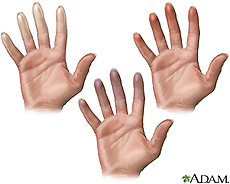 |
 |
 |
Other Health Topics:

-
Related Topics
-
Go Local
- Services and providers for Raynaud's Disease in the U.S.
-
National Institutes of Health
- The primary NIH organization for research on Raynaud's Disease is the National Heart, Lung, and Blood Institute
Raynaud's disease is a rare disorder of the blood vessels, usually in the fingers and toes. People with this disorder have attacks that cause the blood vessels to narrow. When this happens, blood can't get to the surface of the skin and the affected areas turn white and blue. When the blood flow returns, the skin turns red and throbs or tingles. In severe cases, loss of blood flow can cause sores or tissue death. Cold weather and stress can trigger attacks. Often the cause of Raynaud's is not known. People in colder climates are more likely to develop Raynaud's than people in warmer areas.
Treatment for Raynaud's may include drugs to keep the blood vessels open. There are also simple things you can do yourself, such as
- Soaking hands in warm water at the first sign of an attack
- Keeping your hands and feet warm in cold weather
National Heart, Lung, and Blood Institute
-
Questions and Answers about Raynaud's Phenomenon
 (National Institute of Arthritis and Musculoskeletal and Skin Diseases)
(National Institute of Arthritis and Musculoskeletal and Skin Diseases)
-
Raynaud's Disease
 (National Heart, Lung, and Blood Institute)
(National Heart, Lung, and Blood Institute)
| Basics | Learn More | Multimedia & Cool Tools |
|---|---|---|
| Research | Reference Shelf | For You |
|
-
Overviews
- Raynaud's Disease(Mayo Foundation for Medical Education and Research)
-
Diagnosis/Symptoms
- ANA (Antinuclear Antibody Test)(American Association for Clinical Chemistry)
-
Related Issues
- Cold Agglutinin Syndrome: What Are the Symptoms?(Mayo Foundation for Medical Education and Research)
- Limited Scleroderma (CREST Syndrome)(Mayo Foundation for Medical Education and Research)
-
Pictures & Photographs
- Raynaud's Disease(Logical Images)
-
Clinical Trials
-
ClinicalTrials.gov: Raynaud Disease
 (National Institutes of Health)
(National Institutes of Health)
-
ClinicalTrials.gov: Raynaud Disease
-
Journal Articles
References and abstracts from MEDLINE/PubMed (National Library of Medicine)
- Article: Treatment for Raynaud's: beyond calcium channel blockers.
- Article: Hand problems.
- Article: Oral vasodilators for primary Raynaud's phenomenon.
- Raynaud's Disease -- see more articles
- Medical Encyclopedia Return to top
-
Organizations
-
National Institute of Arthritis and Musculoskeletal and Skin Diseases

Also available in Spanish
-
National Institute of Arthritis and Musculoskeletal and Skin Diseases
| Home | Health Topics | Drugs & Supplements | Encyclopedia | Dictionary | News | Directories | Other Resources | |
| Disclaimers | Copyright | Privacy | Accessibility | Quality Guidelines U.S. National Library of Medicine, 8600 Rockville Pike, Bethesda, MD 20894 National Institutes of Health | Department of Health & Human Services |
Date last updated: 26 June 2008 Topic last reviewed: 05 August 2008 |






